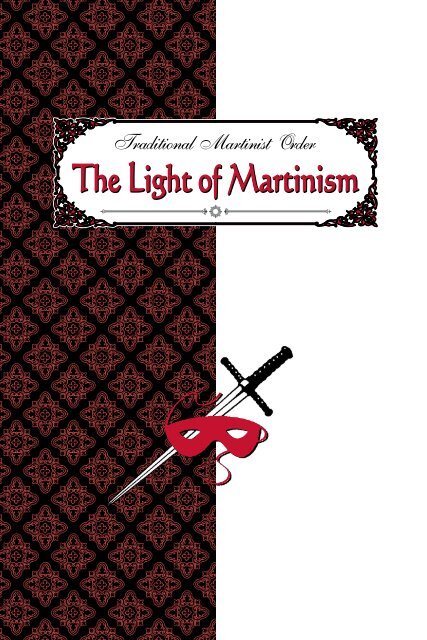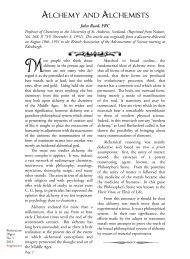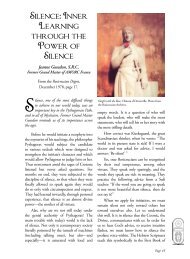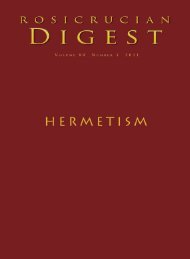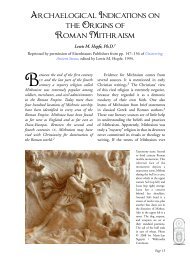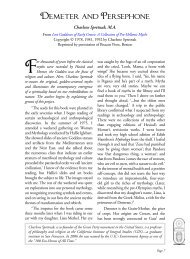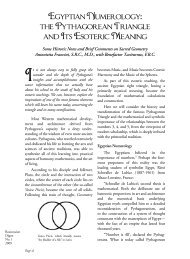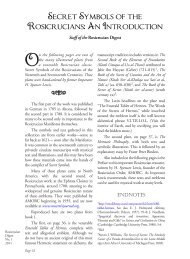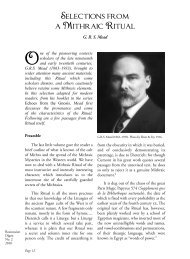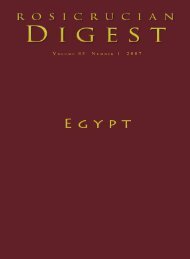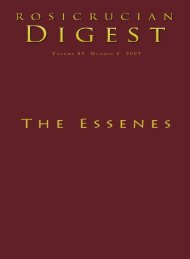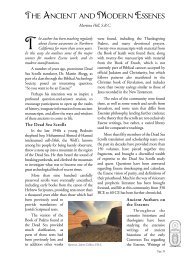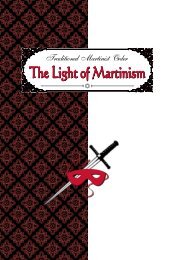The Light of Martinism - Rosicrucian Order
The Light of Martinism - Rosicrucian Order
The Light of Martinism - Rosicrucian Order
You also want an ePaper? Increase the reach of your titles
YUMPU automatically turns print PDFs into web optimized ePapers that Google loves.
®<br />
TRADITIONAL MARTINIST ORDER<br />
®<br />
<strong>The</strong> <strong>Light</strong> <strong>of</strong> <strong>Martinism</strong><br />
© 2011, Supreme Grand Lodge <strong>of</strong> the Ancient & Mystical <strong>Order</strong> Rosae Crucis, Inc.<br />
Published by the Grand Lodge <strong>of</strong> the English Language Jurisdiction, AMORC, Inc.
LOUIS CLAUDE de SAINT-MARTIN<br />
“My task in this world has been to lead human spirits by means <strong>of</strong> a natural<br />
path to the supernatural things, which by right belong to them, but <strong>of</strong> which<br />
they have lost all conception, either by their own debasement or by the false<br />
instruction <strong>of</strong> those who have taught them.”
<strong>The</strong> Martinist Way<br />
<strong>The</strong> Traditional Martinist <strong>Order</strong> is an initiatic <strong>Order</strong> and<br />
a school <strong>of</strong> moral chivalry with its roots in the Western<br />
esoteric tradition. It is open to men and women. Its name<br />
is derived from that <strong>of</strong> Louis Claude de Saint-Martin, who was<br />
a great mystic and powerful Illuminist living in France in the<br />
1700s. He wrote many books under the name <strong>of</strong> “<strong>The</strong> Unknown<br />
Philosopher” concerning our nature and our relationship to the<br />
universe. Through him, the Traditional Martinist <strong>Order</strong> is linked<br />
to a tradition with roots going back to the Primordial Tradition, at<br />
a time when humanity was privileged to unite itself freely with the<br />
Divine, without any intermediary.<br />
Martinists ask themselves whether humanity is now capable <strong>of</strong><br />
bringing about a union with the Divine. If, as indicated in the Bible,<br />
we were created in the image <strong>of</strong> the Divine, how do we explain<br />
humanity’s present miserable situation? This question leads<br />
Martinists to study the history <strong>of</strong> humanity, from emanation out <strong>of</strong><br />
the Divine immensity up to our present conditions.<br />
(1)
For Martinists, there is no knowing humanity’s fundamental<br />
nature except by studying the natural relationships which exist<br />
between the Divine, the universe, and humanity. <strong>The</strong> universe and<br />
humanity form a whole, two progressions linked one to the other<br />
and evolving together. If we wish to understand our true nature<br />
we must look toward the Divine, says Saint-Martin, for “we can<br />
only read ourselves in the Divine, only understand ourselves in the<br />
Divine splendor.” If we are no longer in a position today to reach this<br />
understanding it is because we have made the error <strong>of</strong> separating<br />
ourselves from the Divine and losing ourselves in the world <strong>of</strong><br />
appearances, the temporal world. We have, to some degree, fallen<br />
asleep to the spiritual world. Our inner Temple is in ruins.<br />
<strong>The</strong> Martinist quest lies in determining how we can rediscover<br />
this state <strong>of</strong> paradise in which humanity used to be at once a thought,<br />
a word, and an action <strong>of</strong> the Divine. “Reintegration” is our goal. We<br />
may have lost our original power, but we preserve the seed <strong>of</strong> this<br />
power, nonetheless, and all it takes is the will to cultivate this germ<br />
and make it bear fruit.<br />
We sense full well that we are in a state <strong>of</strong> privation, and nothing<br />
in this lower world is capable <strong>of</strong> satisfying us entirely. What we desire<br />
fundamentally is not <strong>of</strong> this world, and that is why we continually<br />
go astray, being driven by immense longing for that faculty which<br />
previously enabled us to possess all, to rule all, to understand all.<br />
Saint-Martin said, “<strong>The</strong>re is nothing so common as longing and<br />
nothing so rare as desire.” <strong>The</strong> one who realizes the origin <strong>of</strong> this<br />
melancholy feeling, this fleeting memory <strong>of</strong> a lost greatness, who<br />
aspires to rediscover the original purity, is known as a Man or Woman<br />
<strong>of</strong> Desire. His or her desire is that <strong>of</strong> the Divine, and desire is the root<br />
<strong>of</strong> eternity.<br />
To become a Woman or Man <strong>of</strong> Desire is to undertake the<br />
reconstruction <strong>of</strong> the inner Temple. <strong>The</strong> Martinist relies on two pillars<br />
to build this everlasting Temple—that <strong>of</strong> initiation and that <strong>of</strong> the<br />
Martinist teachings. Initiation denotes the beginning <strong>of</strong> this great<br />
work, for it is at this moment that we receive the seed <strong>of</strong> light which<br />
constitutes the foundation <strong>of</strong> our work. It is then up to us to work<br />
to bring into being this light and make it shine. Martinist initiations<br />
(2)
are a privileged moment, the meeting between a Man or Woman <strong>of</strong><br />
Desire and the Initiator. <strong>The</strong>y can only be bestowed in a Temple, with<br />
the joint and active presence <strong>of</strong> the one giving and the one receiving.<br />
Worldly initiations are a necessary preliminary to Martinists,<br />
though we see them as earthly representations <strong>of</strong> a greater<br />
transformation. <strong>The</strong>y only become meaningful when we receive the<br />
“central initiation.” Saint-Martin tells us that this initiation is that<br />
by which “we can enter into the heart <strong>of</strong> the Divine, and make the<br />
Divine’s heart enter into us, there to form an indissoluble marriage<br />
which will make us the spouse <strong>of</strong> our Divine Redeemer. <strong>The</strong>re is no<br />
other mystery in arriving at this holy initiation than to delve further<br />
and further into the depths <strong>of</strong> our being, and not let go until we can<br />
bring forth the living, vivifying root, because then, all the fruit which<br />
we ought to bear, according to our kind, will be produced within and<br />
without ourselves naturally.”<br />
From a plate in the book<br />
Secret Symbols <strong>of</strong> the <strong>Rosicrucian</strong>s <strong>of</strong> the 16th and 17th Centuries.<br />
(3)
<strong>The</strong> Martinist Teachings<br />
<strong>The</strong> teachings represent to a Martinist the nourishment<br />
necessary for the growth <strong>of</strong> the seed received during<br />
initiation. <strong>The</strong> foundations <strong>of</strong> the teachings are the writings<br />
<strong>of</strong> Louis Claude de Saint-Martin and his teacher, Martinès de<br />
Pasqually. Among the subjects <strong>of</strong>fered for consideration are:<br />
Mystical symbols<br />
<strong>The</strong> triune nature <strong>of</strong> humanity<br />
Esoteric study <strong>of</strong> Genesis<br />
Free will and destiny<br />
<strong>The</strong> quaternary law<br />
Reconciliation and reintegration<br />
<strong>The</strong> visible and invisible worlds<br />
Dreams and initiation<br />
<strong>The</strong> science <strong>of</strong> numbers<br />
Prayer<br />
Cycles <strong>of</strong> humanity<br />
Civilization and the ideal state<br />
Art, music, and language<br />
Mystical regeneration<br />
<strong>The</strong> elemental world<br />
<strong>The</strong> world <strong>of</strong> Orbs<br />
<strong>The</strong> Empyrean world<br />
<strong>The</strong> ranks <strong>of</strong> angels<br />
<strong>The</strong> Kabbalah<br />
Meditation on the Sephiroth<br />
In our work, Martinists use neither theurgy nor magic, for we<br />
conform to the ideal <strong>of</strong> the Unknown Philosopher—to guide humanity<br />
by a natural path to the supernatural. For this, it is not necessary to<br />
amass intellectual knowledge, because to progress on the path <strong>of</strong><br />
reintegration, “we must not rack our brains, but our hearts.”<br />
<strong>The</strong> Martinist uses two “books” in this work: one is the<br />
Book <strong>of</strong> Nature and the other the Book <strong>of</strong> Humanity. Nature is<br />
“the true horn <strong>of</strong> plenty for your present state . . . it is in effect<br />
the meeting-point <strong>of</strong> all created virtues. Thus, all these Divine<br />
virtues, ordained by the Great Principle so as to cooperate in our<br />
rehabilitation are always in existence around us.” Divine wisdom<br />
has sown the symbols <strong>of</strong> its virtues all around us that we may learn<br />
to benefit from them. Thus, Nature constitutes an endless source<br />
<strong>of</strong> knowledge for the initiate.<br />
(4)
<strong>The</strong> second “book” entrusted to the Martinist for meditation is<br />
the Book <strong>of</strong> Humanity. For us, this is the essential book. According<br />
to Saint-Martin, we are the “one book written by the hand <strong>of</strong> the<br />
Divine”; it is within us that all the laws <strong>of</strong> the universe are written<br />
and “all these fundamental and important truths exist within all<br />
<strong>of</strong> us before they exist in any book.” It is first within ourselves that<br />
we must search. Reading the Book <strong>of</strong> Humanity, therefore, leads to<br />
introspection and allows the return to the center <strong>of</strong> being, the heart.<br />
Saint-Martin tells us that the heart “is the organ and the place where<br />
all our faculties are centered and where they manifest their action; and<br />
as these faculties relate to all the kingdoms <strong>of</strong> which we are composed,<br />
namely the corporeal, the spiritual, and the divine,” the heart is “the<br />
meeting place and continuous expression <strong>of</strong> the soul and the spirit.”<br />
<strong>The</strong> return <strong>of</strong> a being to its center, this inner contemplation, is the true<br />
prayer, because it “imbues our soul with this sacred charm, this divine<br />
Magian wisdom which is the secret life <strong>of</strong> all beings.”<br />
<strong>The</strong> work <strong>of</strong> the Woman or Man <strong>of</strong> Desire provokes an inner<br />
transformation, a “spiritual inspiration” which heralds an inner<br />
rebirth. Once born as a new man or new woman, we go through all<br />
the stages <strong>of</strong> evolution until we reach complete maturity. Once we<br />
become “human-spirit,” we will be able to fulfill our ministry. In this<br />
mission, we shall accomplish that which was our original destiny,<br />
that is, to be the active intermediary between the Divine and the<br />
Universe. Communication will be reestablished between the high<br />
and low, and Earth will be able to find the Sabbath. Humanity will be<br />
able to participate in the reintegration <strong>of</strong> the whole into the One and<br />
will become again the Temple <strong>of</strong> the Divine.<br />
People <strong>of</strong> peace, men and women <strong>of</strong> desire, such is the splendor <strong>of</strong> the<br />
Temple in which you will one day have the right to take your place. Such<br />
privilege should astonish you less, however, than your ability to commence<br />
building it down here, your ability, in fact, to adorn it at every moment <strong>of</strong><br />
your existence. Remember the teachings <strong>of</strong> the sages, “as above, so below”;<br />
and imagine that you can contribute to this analogy by seeing to it that<br />
“as below, so above.”<br />
—Louis Claude de Saint-Martin<br />
(5)
Tree <strong>of</strong> the Sephiroth as the “Portal <strong>of</strong> <strong>Light</strong>,” the doorway <strong>of</strong> the<br />
Tetragrammaton through which the Just will enter.<br />
(6)
A Brief History <strong>of</strong> <strong>Martinism</strong><br />
<strong>The</strong> foundations <strong>of</strong> the Martinist teachings are the writings<br />
<strong>of</strong> Louis Claude de Saint-Martin and Martinès de<br />
Pasqually. <strong>The</strong> story <strong>of</strong> these two great mystics begins in<br />
the early eighteenth century. In the midst <strong>of</strong> the great political and<br />
economic unrest leading to the French Revolution, France paused to<br />
listen to a debonair, inspiring, mysterious man who awed both the<br />
nobility and the people with the high level <strong>of</strong> mysticism contained in<br />
his published writings. This author signed his books “<strong>The</strong> Unknown<br />
Philosopher.” Where did his great understanding come from? He<br />
could have been easily mistaken for a Sophist, yet he possessed the<br />
gentleness and pr<strong>of</strong>ound understanding <strong>of</strong> a philanthropist.<br />
This person was Louis Claude de Saint-Martin. He dared to<br />
invade the salons <strong>of</strong> the wealthy aristocrats to challenge their jaded<br />
interests with inspiring discourses. He allowed himself to become<br />
the idol <strong>of</strong> French society with but one purpose—to draw their minds<br />
away from their meaningless, self-indulgent existence to contemplate<br />
humanity’s true position in the universe. He wished them to<br />
comprehend the natural connection existing between the Divine,<br />
humanity, and the universe, and to be conscious <strong>of</strong> the special place<br />
we once occupied in our original state and what happened to us during<br />
the course <strong>of</strong> time. Above all, he wanted them to learn how to regain<br />
this glorious former state.<br />
<strong>The</strong> published writings <strong>of</strong> Louis Claude de Saint-Martin<br />
were read in France, Germany, England, and even in Russia. <strong>The</strong><br />
knowledge which he imparted became known under the name <strong>of</strong><br />
<strong>Martinism</strong>. This great teacher refused to take credit for what he<br />
taught, however, instead paying tribute to his initiators. To those<br />
who were worthy, he divulged the secret <strong>of</strong> a higher knowledge they<br />
could access. To attain it, they had to transform themselves, and their<br />
preparation was through initiation.<br />
<strong>The</strong> person to whom Louis Claude de Saint-Martin gave credit<br />
for his teachings was Martinès de Pasqually, a powerful mystic, adept,<br />
(7)
and theurgist <strong>of</strong> the eighteenth century. Tradition indicates he was<br />
well versed in the secret wisdom embodied in the esoteric teachings<br />
<strong>of</strong> Egypt, Greece, and the East. Shortly after 1760, Pasqually went<br />
to Bordeaux and established the headquarters for his order, <strong>The</strong><br />
Masonic Élus-Cohen Knights <strong>of</strong> the Universe.<br />
Saint-Martin, then an <strong>of</strong>ficer in the French Army, learned that<br />
one <strong>of</strong> his fellow <strong>of</strong>ficers was a member <strong>of</strong> this <strong>Order</strong> <strong>of</strong> the Élus-<br />
Cohens (Elect Priests). Through this friend, Saint-Martin met with<br />
the Supreme Master <strong>of</strong> the <strong>Order</strong>, Martinès de Pasqually, and was<br />
immediately captivated by the man’s goals and teachings.<br />
After due preparation and demonstration <strong>of</strong> his worthiness,<br />
Saint-Martin was initiated into the <strong>Order</strong> <strong>of</strong> the Élus-Cohens in<br />
the year 1765, at age 22. He eventually attained the highest degree<br />
<strong>of</strong> that <strong>Order</strong>, that <strong>of</strong> Réau-Croix. But Saint-Martin was not entirely<br />
won over by Pasqually’s methods, which called for theurgic rites, very<br />
complicated ceremonies concerned with perceivable manifestations.<br />
Saint-Martin <strong>of</strong>ten asked Pasqually, “Master, is all that necessary in<br />
order to know the Divine?”<br />
In 1772, personal matters compelled Pasqually to leave France for<br />
Port-au-Prince, Haiti, where he died in 1774. Without its founder, the<br />
<strong>Order</strong> progressively fell dormant. His two ablest disciples were Saint-<br />
Martin and Jean-Baptiste Willermoz. Willermoz joined with some<br />
members <strong>of</strong> the Élus-Cohens and the <strong>Order</strong> <strong>of</strong> the Strict German<br />
Templar Observance. <strong>The</strong>y reorganized themselves by adopting<br />
part <strong>of</strong> the theoretical teachings <strong>of</strong> Martinès de Pasqually to create<br />
an order called “<strong>The</strong> Charitable Knights <strong>of</strong> the Holy City.” Others<br />
joined this <strong>Order</strong>, but Saint-Martin, seeing that they were not so<br />
much seeking the truth as the Philosopher’s Stone, chose to follow an<br />
independent path.<br />
(8)
<strong>The</strong>urgic diagram <strong>of</strong> the Élus-Cohens from an original document kept in<br />
the French National Library.<br />
(9)
Saint-Martin traveled to England, Italy, and Germany to study<br />
humanity and nature and to compare the findings <strong>of</strong> others with his<br />
own. It was in Strasbourg, a city in northeast France, that he became<br />
acquainted with the works <strong>of</strong> Jakob Boehme (1575–1624), which<br />
revolutionized his whole mystical life. Jakob Boehme became for<br />
Saint-Martin his “second teacher.” In order to read Boehme’s texts in<br />
their original language, Saint-Martin learned German at the age <strong>of</strong><br />
forty-five. Through a study <strong>of</strong> Boehme, he realized that true initiation<br />
surpasses theurgic rituals; there is no need to call upon intermediary<br />
powers <strong>of</strong> creation through complex and <strong>of</strong>ten dangerous ceremonies.<br />
Initiation can only be produced with the heart. This is what is called<br />
“<strong>The</strong> Way <strong>of</strong> the Heart.”<br />
Design from a plate excerpted from the book<br />
Secret Symbols <strong>of</strong> the <strong>Rosicrucian</strong>s <strong>of</strong> the 16th and 17th Centuries.<br />
From this point until the end <strong>of</strong> his life, Saint-Martin made a<br />
daily task <strong>of</strong> translating the texts <strong>of</strong> Jakob Boehme. “I owe my entry<br />
into the higher truths to Martinès de Pasqually, and I owe the most<br />
important steps I have made into these truths to Jakob Boehme.”<br />
Saint-Martin published his first work in 1775 under the title Of<br />
Errors and Of Truth, or Humanity Recalled to the Universal Principle <strong>of</strong><br />
Science. <strong>The</strong> book’s purpose was to combat the atheism <strong>of</strong> his time. As<br />
with all his other writings, this was published under the pseudonym<br />
<strong>of</strong> “<strong>The</strong> Unknown Philosopher.”<br />
During the many years <strong>of</strong> his literary activity, Louis Claude de<br />
Saint-Martin wrote numerous works, including <strong>The</strong> Natural View<br />
(10)
<strong>of</strong> the Connections Existing Between the Divine, Humanity, and the<br />
Universe; <strong>The</strong> Person <strong>of</strong> Desire; <strong>The</strong> New Person; <strong>The</strong> Spirit <strong>of</strong> Things; and<br />
<strong>The</strong> Ministry <strong>of</strong> the Human-Spirit. He also left to posterity a revealing<br />
and inspiring personal correspondence, as well as a few posthumous<br />
works. In addition, he published translations <strong>of</strong> the writings <strong>of</strong> the<br />
one he called his “most dear B” (Jakob Boehme): <strong>The</strong> Birth <strong>of</strong> Dawn;<br />
<strong>The</strong> Three Principles <strong>of</strong> the Divine Essence; Forty Questions on the Soul;<br />
<strong>The</strong> Triple Life <strong>of</strong> Humanity; and Six Points and Nine Texts.<br />
<strong>The</strong> philosophical works <strong>of</strong> Louis Claude de Saint-Martin<br />
aroused much interest. In order to study his teachings, a circle <strong>of</strong><br />
disciples was formed, known by the name <strong>of</strong> Society <strong>of</strong> Intimates.<br />
This society was working for the purest forms <strong>of</strong> spirituality. Saint-<br />
Martin accepted very few men and women into his society, always<br />
exercising extreme prudence.<br />
Despite the political and social turbulence <strong>of</strong> the French<br />
Revolution, Louis Claude de Saint-Martin was never seriously<br />
harassed during the Reign <strong>of</strong> Terror, or at any other time during the<br />
Revolution. On October 13, 1803, at the age <strong>of</strong> sixty, Louis Claude de<br />
Saint-Martin went through transition following a stroke.<br />
<strong>The</strong> name <strong>of</strong> the Divine which burns in the heart and soul <strong>of</strong> humanity.<br />
From the Collected Works <strong>of</strong> Jakob Boehme.<br />
(11)
Modern <strong>Martinism</strong><br />
Following Louis Claude de Saint-Martin’s death, the<br />
Martinist disciples were not very active. <strong>The</strong> traditional<br />
teachings and ceremonies were privately transmitted<br />
by groups <strong>of</strong> initiators, spreading principally throughout Italy,<br />
Germany, and France. After a long period <strong>of</strong> secrecy, a great effort<br />
was undertaken in 1888 to restructure <strong>Martinism</strong> into an initiatic<br />
order. It is due to the efforts <strong>of</strong> Dr. Gérard Encausse (Papus) and<br />
Augustin Chaboseau that this order survived and took on the<br />
name Martinist <strong>Order</strong>. <strong>The</strong>ir efforts were rewarded with success<br />
in 1891 with the formation <strong>of</strong> a Supreme Council <strong>of</strong> the Martinist<br />
<strong>Order</strong>, consisting <strong>of</strong> twenty-one members with authority over all<br />
the lodges in the world. Papus, a well-known French esotericist,<br />
was elected the first President <strong>of</strong> the Supreme Council. Under his<br />
brilliant and tireless direction, the <strong>Order</strong> grew rapidly, and by 1900,<br />
it could account for several hundred members in most parts <strong>of</strong> the<br />
world. Papus soon became an authority on <strong>Martinism</strong>, and his works<br />
constitute a precious source <strong>of</strong> information for Martinists and all<br />
those interested in the tradition.<br />
World War I (1914–1918) greatly affected the growth and activities<br />
<strong>of</strong> the <strong>Order</strong>. Papus died heroically carrying out his duties as a medical<br />
doctor, and many other leaders and members <strong>of</strong> the <strong>Order</strong> did not<br />
survive. It was finally revived in 1931 due to the efforts <strong>of</strong> Augustin<br />
Chaboseau, the co-founder <strong>of</strong> the Martinist <strong>Order</strong> with Papus. He,<br />
along with the two other remaining survivors <strong>of</strong> the 1891 Supreme<br />
Council, created the Traditional Martinist <strong>Order</strong> to distinguish it<br />
from several movements which wrongly claimed to be the successors<br />
<strong>of</strong> Papus. Augustin Chaboseau, who was a descendant <strong>of</strong> an<br />
uninterrupted filiation back to Louis Claude de Saint-Martin, served<br />
as Grand Master and President <strong>of</strong> the Supreme Council until his<br />
transition on January 2, 1946.<br />
Ralph Maxwell Lewis, Imperator <strong>of</strong> the Ancient and Mystical<br />
<strong>Order</strong> Rosae Crucis, was received into the Traditional Martinist<br />
(12)
<strong>Order</strong> on September 1, 1939, by Georges Lagrèze, legate and<br />
representative <strong>of</strong> Augustin Chaboseau. Consequently, the charters,<br />
manifestos, and all other documents needed for the promotion and<br />
development <strong>of</strong> <strong>Martinism</strong> in the Americas were transmitted to<br />
Ralph M. Lewis just prior to the oppression which the Traditional<br />
Martinist <strong>Order</strong> had to endure in Europe during the Second<br />
World War.<br />
Currently, the Supreme Council <strong>of</strong> the Traditional Martinist<br />
<strong>Order</strong> is directed and presided over by the Sovereign Grand Master,<br />
Christian Bernard, Imperator <strong>of</strong> the <strong>Rosicrucian</strong> <strong>Order</strong>, AMORC.<br />
<strong>The</strong> Traditional Martinist <strong>Order</strong> goes back through an initiatic<br />
transmission which is absolutely authentic, to the purest sources <strong>of</strong><br />
<strong>Martinism</strong>. Thus, the Martinist light has been able to shine, spread,<br />
and increase, without interruption, its original luster.<br />
(13)
Becoming a Martinist<br />
<strong>The</strong>re are two levels <strong>of</strong> Martinist affiliation:<br />
1. Oratory or Home Study membership:<br />
To all those interested in pursuing the Martinist teachings, we<br />
<strong>of</strong>fer an Oratory or Home Study program. This type <strong>of</strong> membership<br />
entitles you to receive at home four Martinist discourses every month,<br />
to be studied in a manner that will be indicated to you. Although selfinitiation<br />
is not part <strong>of</strong> the Martinist system <strong>of</strong> study, you will receive<br />
a ritual to mark the beginning <strong>of</strong> each level in your Oratory work.<br />
(14)
Oratory study will familiarize you with the theoretical teachings <strong>of</strong><br />
the TMO, however it will not <strong>of</strong>fer the three traditional initiations,<br />
which confer upon you the status <strong>of</strong> a true Martinist initiate. Instead<br />
you become a student <strong>of</strong> <strong>Martinism</strong>.<br />
To enroll yourself in this type <strong>of</strong> membership, please complete the<br />
enclosed application and send it with appropriate dues made payable<br />
to the Traditional Martinist <strong>Order</strong>. If it is accepted, you will receive<br />
your first packet <strong>of</strong> discourses within a short time. <strong>The</strong>n please join us<br />
online at www.martinistcommunity.org.<br />
If you do not wish to receive Home Oratory Lessons but only to<br />
join a local group, please enroll with the Grand Heptad as a “Heptad<br />
Only” member.<br />
2. Membership in a local Heptad:<br />
<strong>The</strong> traditional method <strong>of</strong> Martinist membership is <strong>of</strong>fered<br />
through initiation and learning in a Martinist Heptad. <strong>The</strong> word<br />
“Heptad” comes from the Greek hepta, which designates the number<br />
seven. Thus, a Heptad is a local body under the supervision <strong>of</strong> the<br />
seven <strong>of</strong>ficers in charge. Work in the Heptad is conducted in the<br />
strictest traditional manner, and initiations are conferred with the<br />
active physical presence <strong>of</strong> the candidate and an initiator, who is an<br />
<strong>of</strong>ficer duly initiated and empowered by the directives <strong>of</strong> the Martinist<br />
Tradition to initiate others.<br />
This form <strong>of</strong> affiliation is open to those who are able to attend<br />
the meetings or classes, called “conventicles,” which are held either<br />
weekly or monthly at the local Heptad. <strong>The</strong>se meetings are conducted<br />
in the Heptad temple, and include a Martinist ritual followed by an<br />
active discussion among class members and the class master <strong>of</strong> the<br />
concepts presented in the Heptad discourse. Members who complete<br />
their studies and initiations in the Heptad, which takes a minimum<br />
<strong>of</strong> six years, become full-fledged initiates in a chain <strong>of</strong> <strong>Light</strong> extending<br />
back to Louis Claude de Saint-Martin himself. Smaller Martinist<br />
groups, known as Ateliers (Workshops), also <strong>of</strong>fer classes and the<br />
Associate Degree Initiation.<br />
(15)
If this type <strong>of</strong> membership appeals to you, please first complete<br />
the enclosed application for admission into the Traditional Martinist<br />
<strong>Order</strong>, choosing either “Home Oratory” (receiving lessons at home)<br />
or “Heptad Only” (no lessons at home) Membership, and enclose<br />
the dues applicable for the category <strong>of</strong> membership you have selected.<br />
Once you have been accepted as a member <strong>of</strong> the Grand Heptad,<br />
please join us at www.martinistcommunity.org to connect with other<br />
Martinists and to find the Heptad nearest you. Membership in a<br />
local group will require modest dues to help support the expenses <strong>of</strong><br />
the local Heptad or Atelier.<br />
For those who live in an area where there is no Heptad or Atelier<br />
but who desire to be initiated into the Martinist Tradition, the option<br />
is <strong>of</strong>fered to receive the first Martinist initiation only (the Associate<br />
Initiation) at a distant Heptad or Atelier or at a regional convention,<br />
if it is being <strong>of</strong>fered. This allows those who are unable to participate<br />
in the classes and activities <strong>of</strong> a local group with regularity, or who<br />
live in a place where none are available, to attend general Martinist<br />
conventicles held during national or worldwide <strong>Rosicrucian</strong><br />
conventions, or to visit a nearby group on occasion for special events<br />
(such as the <strong>of</strong>ficial visit <strong>of</strong> a Provincial Master, the annual Feast <strong>of</strong><br />
Ieschouah, or a General Conventicle with a guest speaker, etc.).<br />
Members <strong>of</strong> the Traditional Martinist <strong>Order</strong> are free to<br />
discontinue their membership at any time. If they are Home Oratory<br />
members, they must return the teachings that they have received to<br />
the Grand Master <strong>of</strong> the <strong>Order</strong>. Heptad Only members who wish to<br />
resign for any reason are required to keep confidential any information<br />
they have received during their active affiliation in the local group.<br />
(16)
If you have additional questions, please contact:<br />
tmo@rosicrucian.org<br />
(408) 947-3600<br />
Traditional Martinist <strong>Order</strong><br />
<strong>Rosicrucian</strong> Park<br />
1342 Naglee Avenue<br />
San Jose, CA 95191-0001<br />
U.S.A.<br />
(17)
“I have desired to do good,<br />
but I have not desired to<br />
make noise, because I have<br />
felt that noise did no good<br />
and that good made<br />
no noise.”<br />
Louis Claude de Saint-Martin<br />
(18)
TMO-01 Rev. 1111<br />
Printed on 100% recycled post-consumer<br />
fiber using soy-based ink.


